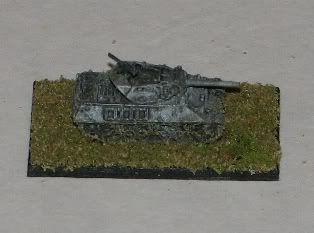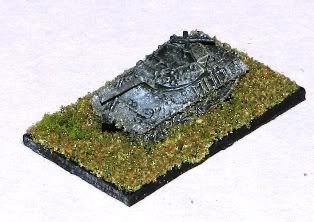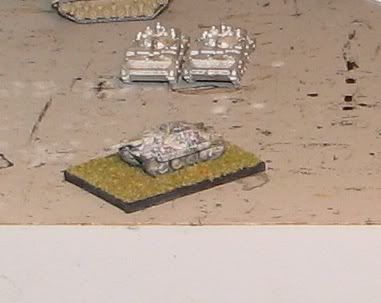White wash
Moderators: dnichols, GHQ, Mk 1
-
Mickel
- E5
- Posts: 326
- Joined: Sun Jan 23, 2005 2:00 pm
- Location: Adelaide, Australia
White wash
Folks
I'm about to start a small winter '42/'43 force for both sides on the eastern front. The original plan was to paint everything white, but that's probably going to be a bit boring. So I'm thinking that some stuff should get a white wash over the green or grey of the base colour.
I use a white spray on undercoat and Humbrol enamels for top coat. To to achieve the white wash I thought I'd do the base grey/green colour, but not get too fussy about it. Then I'd get some left over Tamiya (yuck) white acrylic, thin it down a bit and wash it over the tanks. Follow that by a thin black wash and dirty dry brush, especially around the running gear.
Any other suggestions? At some point I'll be doing the same for western front, winter '44/'45.
Mike
I'm about to start a small winter '42/'43 force for both sides on the eastern front. The original plan was to paint everything white, but that's probably going to be a bit boring. So I'm thinking that some stuff should get a white wash over the green or grey of the base colour.
I use a white spray on undercoat and Humbrol enamels for top coat. To to achieve the white wash I thought I'd do the base grey/green colour, but not get too fussy about it. Then I'd get some left over Tamiya (yuck) white acrylic, thin it down a bit and wash it over the tanks. Follow that by a thin black wash and dirty dry brush, especially around the running gear.
Any other suggestions? At some point I'll be doing the same for western front, winter '44/'45.
Mike
-
tstockton
- E5
- Posts: 715
- Joined: Sat Apr 16, 2005 10:55 pm
- Location: Indiana
- Contact:
Mickel,
Seems to me that a "kind-of drybrushing" the white might work better than thinning it -- keep just a little more white paint on the brush -- painting the "more exposed" areas, while leaving the "undercolor" visible in cracks, crevases, etc. And then do your blackwash and "dirty" drybrushing, etc.
Sounds like the results will be pretty cool -- if you could, I'd love to see pictures of your finished armor when you get them done!
Regards,
Tom Stockton
Seems to me that a "kind-of drybrushing" the white might work better than thinning it -- keep just a little more white paint on the brush -- painting the "more exposed" areas, while leaving the "undercolor" visible in cracks, crevases, etc. And then do your blackwash and "dirty" drybrushing, etc.
Sounds like the results will be pretty cool -- if you could, I'd love to see pictures of your finished armor when you get them done!
Regards,
Tom Stockton
"Well, I've been to one World's Fair, a picnic, and a rodeo, and that's the stupidest thing I ever heard come over a set of earphones. You sure you got today's codes?"
-- Major T. J. "King" Kong in "Dr. Strangelove"
-- Major T. J. "King" Kong in "Dr. Strangelove"
-
mluther
- E5
- Posts: 212
- Joined: Wed Nov 15, 2006 10:09 pm
- Location: Atlanta, GA
whitewash
I agree with Tom. But then do some drybrushing with the darker undercolor. The whitewash wears off on the more exposed surfaces. On any of the areas that have heavy traffic, i.e., tank riders, that area is going to be whitewash free. This is also the chance to add some bright color/recognition sign to the top of the tank. It makes a nice contrast to the mainly white vehicle to see a red stripe or triangle on the top of the turret.
Mark
Mark
-
Cav Dog
- E5
- Posts: 898
- Joined: Wed Dec 29, 2004 1:12 am
-
pmskaar
- E5
- Posts: 2208
- Joined: Sun Apr 17, 2005 5:45 am
Winter Whitewash
Grant
Really excellent work on that Pz IVF2. Some of the best winter stuff I've seen! Really great.
Pete - Binpicker, Out!
Really excellent work on that Pz IVF2. Some of the best winter stuff I've seen! Really great.
Pete - Binpicker, Out!
-
Mickel
- E5
- Posts: 326
- Joined: Sun Jan 23, 2005 2:00 pm
- Location: Adelaide, Australia

Waddayareckon? It's painted as per the method I described, however I took your advice and didn't thin the white - just a dryish brush. I might have underdone the white a bit, but I was a little concerned about over doing it.

This one has the 'auto-correct' thing on, which I guess assumes the background is white, which isn't strictly true, so it's all a little bright. The actual shade is somewhere between them.
I'll find a suitable snow cover to put over the base to make it fit the camo a bit more. Muggins forgot to brush out the suspension before taking the pic, so that flock isn't there any more.
Mike
-
hauptgrate
- Posts: 69
- Joined: Tue Jan 24, 2006 2:39 am
I have seen pictures of many different application methods: brushing, brooms, rags, just throwing it on, etc. In 1941 the Germans sometimes resorted to bedsheets and piles of real snow -- both also done by U.S. forces in 1944. Also, all winter camo was temporary -- the white paints issued were meant to wash off rather easily. So..... almost any technique of application and weathering will work for your models. It might even be cool to use different techniques on different models to add variety.
-
Hugewally
- E5
- Posts: 133
- Joined: Wed Jun 21, 2006 10:30 pm
- Location: Largo, FL USA
- Contact:
These must be 20 years old by now, but they're just a sampling of the winter stuff we had back then.
KV-IIs Notice that the middle tank wasn't completely white washed. I also tried to show with the painting, a more complete coverage on the front half of the other vehicles as compared to a thinner or quickly applied paint in the rear half.
I think you'll find that most of the vehicles that got winter paint mainly had the paint applied on the surfaces that would 'normally' face the enemy, so the backside would be left in the standard paint scheme.
And as mark mentioned above, foot and hand traffic areas (along with spilled fuel) will have the paint either worn off/ thinned or covered with mud.

KV-IIs Notice that the middle tank wasn't completely white washed. I also tried to show with the painting, a more complete coverage on the front half of the other vehicles as compared to a thinner or quickly applied paint in the rear half.
I think you'll find that most of the vehicles that got winter paint mainly had the paint applied on the surfaces that would 'normally' face the enemy, so the backside would be left in the standard paint scheme.
And as mark mentioned above, foot and hand traffic areas (along with spilled fuel) will have the paint either worn off/ thinned or covered with mud.

Martin
-
rct75001
- E5
- Posts: 165
- Joined: Sun Dec 12, 2004 5:47 am
- Location: Sydney, Australia
-
AceRimmer
- Posts: 8
- Joined: Wed May 23, 2007 12:28 am
Hi..
Yes I use very light coats of Testors dullcote spray....
Like yourself I find I lose some of the lighter pigments as it seems to darken everything slightly, so I just compensate by using a lighter shade than I really want..
Another way to use it is mix it with a very watered down white paint, the paint helps to make it stick..
All trial and error at the moment as im just doing my 1st batch of 6mm vehicles, im having lots of errors but I will get there in the end.
Yes I use very light coats of Testors dullcote spray....
Like yourself I find I lose some of the lighter pigments as it seems to darken everything slightly, so I just compensate by using a lighter shade than I really want..
Another way to use it is mix it with a very watered down white paint, the paint helps to make it stick..
All trial and error at the moment as im just doing my 1st batch of 6mm vehicles, im having lots of errors but I will get there in the end.


